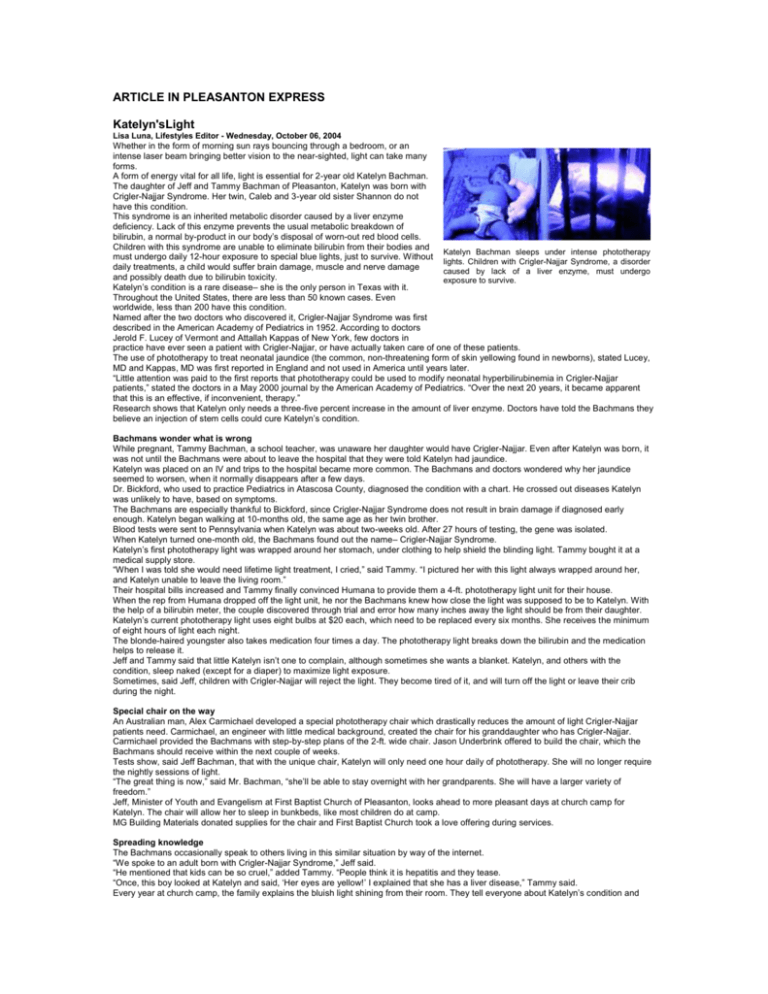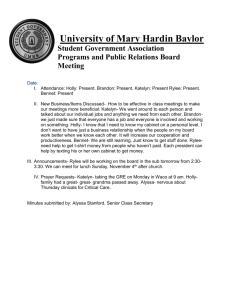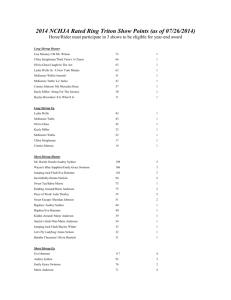ARTICLE IN PLEASANTON EXPRESS
advertisement

ARTICLE IN PLEASANTON EXPRESS Katelyn'sLight Lisa Luna, Lifestyles Editor - Wednesday, October 06, 2004 Whether in the form of morning sun rays bouncing through a bedroom, or an intense laser beam bringing better vision to the near-sighted, light can take many forms. A form of energy vital for all life, light is essential for 2-year old Katelyn Bachman. The daughter of Jeff and Tammy Bachman of Pleasanton, Katelyn was born with Crigler-Najjar Syndrome. Her twin, Caleb and 3-year old sister Shannon do not have this condition. This syndrome is an inherited metabolic disorder caused by a liver enzyme deficiency. Lack of this enzyme prevents the usual metabolic breakdown of bilirubin, a normal by-product in our body’s disposal of worn-out red blood cells. Children with this syndrome are unable to eliminate bilirubin from their bodies and Katelyn Bachman sleeps under intense phototherapy must undergo daily 12-hour exposure to special blue lights, just to survive. Without lights. Children with Crigler-Najjar Syndrome, a disorder daily treatments, a child would suffer brain damage, muscle and nerve damage caused by lack of a liver enzyme, must undergo and possibly death due to bilirubin toxicity. exposure to survive. Katelyn’s condition is a rare disease– she is the only person in Texas with it. Throughout the United States, there are less than 50 known cases. Even worldwide, less than 200 have this condition. Named after the two doctors who discovered it, Crigler-Najjar Syndrome was first described in the American Academy of Pediatrics in 1952. According to doctors Jerold F. Lucey of Vermont and Attallah Kappas of New York, few doctors in practice have ever seen a patient with Crigler-Najjar, or have actually taken care of one of these patients. The use of phototherapy to treat neonatal jaundice (the common, non-threatening form of skin yellowing found in newborns), stated Lucey, MD and Kappas, MD was first reported in England and not used in America until years later. “Little attention was paid to the first reports that phototherapy could be used to modify neonatal hyperbilirubinemia in Crigler-Najjar patients,” stated the doctors in a May 2000 journal by the American Academy of Pediatrics. “Over the next 20 years, it became apparent that this is an effective, if inconvenient, therapy.” Research shows that Katelyn only needs a three-five percent increase in the amount of liver enzyme. Doctors have told the Bachmans they believe an injection of stem cells could cure Katelyn’s condition. Bachmans wonder what is wrong While pregnant, Tammy Bachman, a school teacher, was unaware her daughter would have Crigler-Najjar. Even after Katelyn was born, it was not until the Bachmans were about to leave the hospital that they were told Katelyn had jaundice. Katelyn was placed on an IV and trips to the hospital became more common. The Bachmans and doctors wondered why her jaundice seemed to worsen, when it normally disappears after a few days. Dr. Bickford, who used to practice Pediatrics in Atascosa County, diagnosed the condition with a chart. He crossed out diseases Katelyn was unlikely to have, based on symptoms. The Bachmans are especially thankful to Bickford, since Crigler-Najjar Syndrome does not result in brain damage if diagnosed early enough. Katelyn began walking at 10-months old, the same age as her twin brother. Blood tests were sent to Pennsylvania when Katelyn was about two-weeks old. After 27 hours of testing, the gene was isolated. When Katelyn turned one-month old, the Bachmans found out the name– Crigler-Najjar Syndrome. Katelyn’s first phototherapy light was wrapped around her stomach, under clothing to help shield the blinding light. Tammy bought it at a medical supply store. “When I was told she would need lifetime light treatment, I cried,” said Tammy. “I pictured her with this light always wrapped around her, and Katelyn unable to leave the living room.” Their hospital bills increased and Tammy finally convinced Humana to provide them a 4-ft. phototherapy light unit for their house. When the rep from Humana dropped off the light unit, he nor the Bachmans knew how close the light was supposed to be to Katelyn. With the help of a bilirubin meter, the couple discovered through trial and error how many inches away the light should be from their daughter. Katelyn’s current phototherapy light uses eight bulbs at $20 each, which need to be replaced every six months. She receives the minimum of eight hours of light each night. The blonde-haired youngster also takes medication four times a day. The phototherapy light breaks down the bilirubin and the medication helps to release it. Jeff and Tammy said that little Katelyn isn’t one to complain, although sometimes she wants a blanket. Katelyn, and others with the condition, sleep naked (except for a diaper) to maximize light exposure. Sometimes, said Jeff, children with Crigler-Najjar will reject the light. They become tired of it, and will turn off the light or leave their crib during the night. Special chair on the way An Australian man, Alex Carmichael developed a special phototherapy chair which drastically reduces the amount of light Crigler-Najjar patients need. Carmichael, an engineer with little medical background, created the chair for his granddaughter who has Crigler-Najjar. Carmichael provided the Bachmans with step-by-step plans of the 2-ft. wide chair. Jason Underbrink offered to build the chair, which the Bachmans should receive within the next couple of weeks. Tests show, said Jeff Bachman, that with the unique chair, Katelyn will only need one hour daily of phototherapy. She will no longer require the nightly sessions of light. “The great thing is now,” said Mr. Bachman, “she’ll be able to stay overnight with her grandparents. She will have a larger variety of freedom.” Jeff, Minister of Youth and Evangelism at First Baptist Church of Pleasanton, looks ahead to more pleasant days at church camp for Katelyn. The chair will allow her to sleep in bunkbeds, like most children do at camp. MG Building Materials donated supplies for the chair and First Baptist Church took a love offering during services. Spreading knowledge The Bachmans occasionally speak to others living in this similar situation by way of the internet. “We spoke to an adult born with Crigler-Najjar Syndrome,” Jeff said. “He mentioned that kids can be so cruel,” added Tammy. “People think it is hepatitis and they tease. “Once, this boy looked at Katelyn and said, ‘Her eyes are yellow!’ I explained that she has a liver disease,” Tammy said. Every year at church camp, the family explains the bluish light shining from their room. They tell everyone about Katelyn’s condition and that, contrary to the suspicions of teenagers, they are not throwing some party with blue light. Doctors have told the couple that Katelyn should expect to live a normal life, but that she fatigues easily. “At night time,” said Tammy, “she’s the first one to fall asleep.” When daughter Shannon was younger, the Bachmans only put the phototherapy light on after Shannon fell asleep. The couple now has a timer for the light, so they don’t have to enter Katelyn’s room to turn on the light, possibly waking her up. Shannon and Caleb are usually asleep when the light goes on. The few times that the other children have seen Katelyn’s room illuminated in blue, Tammy explains to them, “It’s Katelyn’s light.” “There is a purpose for everything,” said Jeff, with a smile. “We know that God has a plan for Katelyn.”







